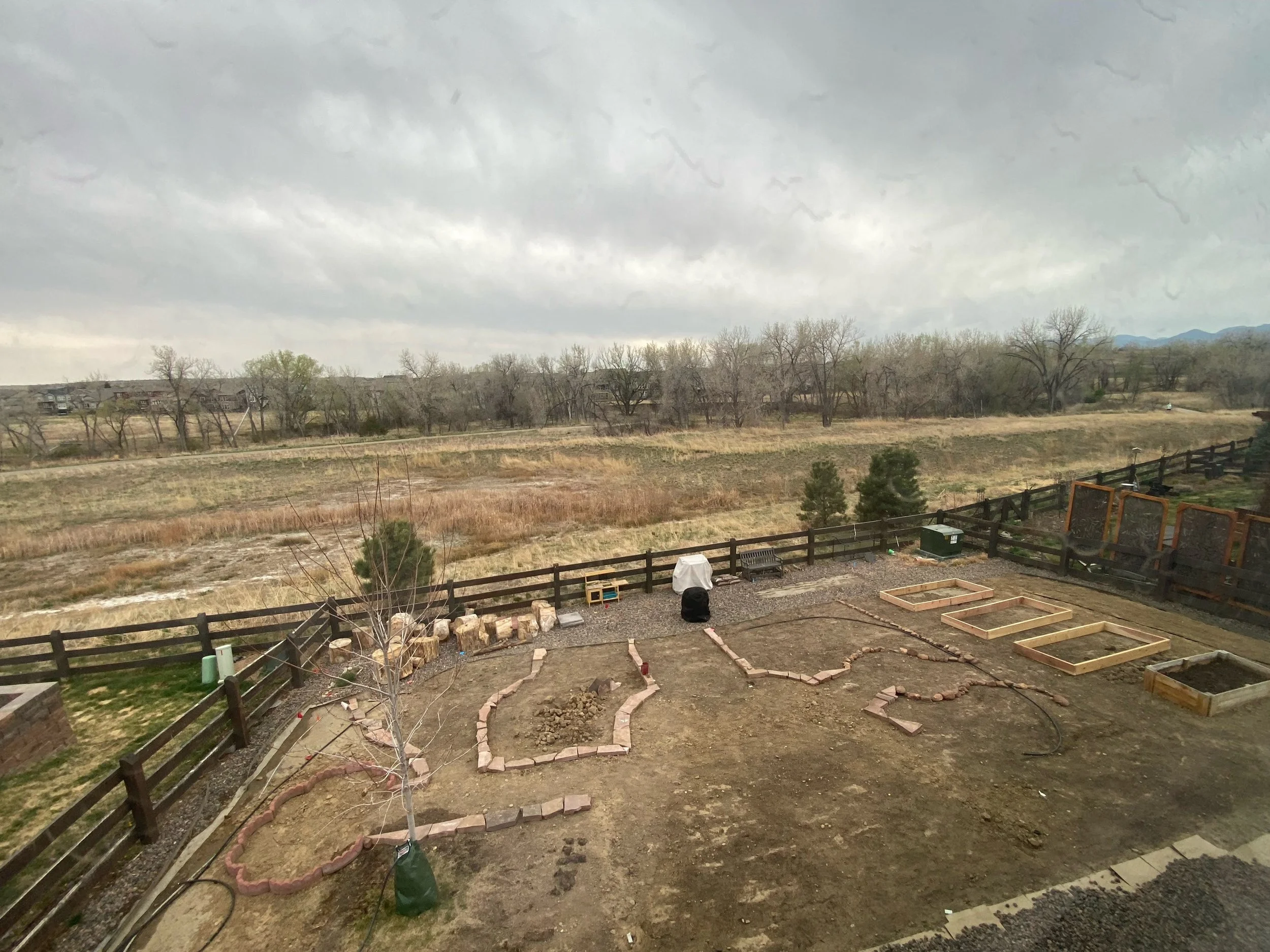Backyard Biodiversity Project, Part 3: Native Lawns
Avert your eyes from the naked dirt. Amy’s biodiverse backyard, stripped of sod, begins to take shape.
So, let’s talk about turf.
There’s a common misconception that native and/or xeric landscapes cannot include turf grass. That’s because when we think of turf, we think of Kentucky bluegrass, a non-native sod-forming species that is water intensive (and it’s not even from Kentucky). But the shortgrass prairies that existed here for thousands of years were dominated by both buffalograss and blue grama, two native, water-sipping, sod-forming species. Grass fits here.
A grass area was important to my design. We wanted to highlight and unify the planted beds, to walk barefoot outside, and we wanted some space for the kids to play. But I couldn’t decide if I wanted buffalograss alone or in a mix with blue grama.
After reading some things written by Tony Koski, the CSU Extension Turf Specialist, we decided to use the Sundancer buffalograss cultivar, which has been selected to make an attractive lawn that will stand up well to regular light foot traffic and occasional heavy foot traffic. Cultivars are not generally as beneficial to wildlife as straight species, but we decided that this was a compromise we were willing to make to try and have a successful native lawn.
But how to remove the existing lawn? There are several options:
Mechanical Having your sod removed is expensive because it takes time and the sod isn’t that easy to get rid of (if you have healthy sod that you might be able to give away, or if you can use dried out sod to create berms or feed food gardens, this becomes more cost effective). If you’re up for it, you can rent a sod-remover and DIY as well. Depending where you live and on the size of your lawn, you may get rebates that make Resource Central’s lawn removal cost effective: https://resourcecentral.org/lawn/lrs/
Chemical Glyphosate. I know a lot of us don’t want to use chemicals that can harm the environment. However, lots of native plant advocates and ecologists recommend using glyphosate in accordance with the directions as a good option to remove lawns and noxious weeds. Most of the ecological damage comes from using more glyphosate than directed or not following the directions, and the health risks can be avoided by using proper Personal Protective Equipment. This also needs to be done when the grass is growing (not dormant).
Solarizing Cover the lawn with plastic and let it bake in the hot sun for six weeks in the height of the summer to kill it. This will also kill anything else living in the top of the soil, so you will be left with dead soil, and will have to replace the good fungi and bacteria that make soil healthy. Having a sheet of plastic on your lawn for a month and a half may be visually unappealing for you and your neighbors.
Composting Known as lasagne gardening, it involves covering the lawn with cardboard, wood mulch and then with a layer of dirt, and you have it keep it moist. All that wood mulch might make the soil too rich for native plants, but many people swear by this method – it’s easy and fast and relatively cheap.
We wanted to get this done in the spring, so solarizing wasn’t an option, since it needs to be done when it’s really hot out. At the time we weren’t comfortable using a large amount of glyphosate, although I now understand that if used according to directions it likely isn’t problematic. I was concerned about the native plants having too many nutrients from lasagne gardening, so I decided to have a landscaper remove the sod. After we made this choice, we found out that it’s almost impossible to have sod commercially composted, which was surprising to me. We had to rent a dumpster and pay by the pound for sod disposal. I was surprised how much volume and weight of sod came from our ~900sf lawn.
Finally, we had to figure out irrigation. Did we want to have irrigation set up in the native plant gardens? These plants shouldn’t need much water to survive once they are established, but getting them established requires regular watering. Because we had an existing irrigation system from the lawn, we decided to modify it so it could help us get the gardens established.
I was especially concerned about the watering recommendations for seeding buffalograss – water 3 times per day from seeding until 2 weeks after the seed germinates (a total of 4-5 weeks), and then once a day for another 2 weeks. I didn’t think I could keep this up with hand watering, although in hindsight I probably could have put a regular lawn sprinkler on a timer and done it that way. We converted one sprinkler zone to a drip system for the native gardens, moved another to water the buffalograss, and planned to use the existing drip line for the fruit and vegetable gardens.
This ended up being our biggest mistake. While I appreciate having the ability to water the gardens while I'm away on vacation (which is the only time I really use them), I underestimated the cost of changing the sprinklers, and in hindsight I probably wouldn't have done it other than for the food plants. Overall, irrigation adjustments totaled about $1,500 (including watering for the food plants) - I probably could have saved over half of that by not having sprinklers for the buffalograss, as there was a lot of trenching to get the sprinkler lines in the right spots. Live and learn.

